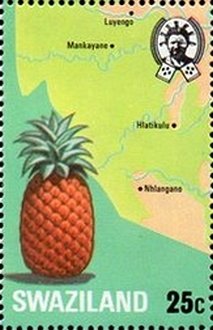Stamp: Pineapple (Swaziland 1977)
Pineapple (Swaziland 1977)
17 October (Swaziland ) within release Maps and produce goes into circulation Stamp Pineapple face value 25 Swazi cent
| Stamp Pineapple in catalogues | |
|---|---|
| Stamp Number: | Sn:SZ 293c |
Stamp is square format.
Also in the issue Maps and produce:
- Stamp - Cattle (Bos primigenius indicus) face value 25;
- Stamp - Evergreens, timber, map of Highveld face value 5;
- Stamp - Pineapple, map of Middleveld face value 10;
- Stamp - Map of Lowveld, orange and lemon face value 15;
- Stamp - Map of Lubombo, Cattle (Bos primigenius taurus) face value 20;
- Stamp - Evergreens face value 25;
- Stamp - Orange and lemon face value 25;
- Stamp - Pineapple face value 25;
- Souvenir Sheet - Map of Swaziland and produce face value 1;
Stamp Pineapple it reflects the thematic directions:
A map is a symbolic depiction emphasizing relationships between elements of some space, such as objects, regions, or themes. Many maps are static, fixed to paper or some other durable medium, while others are dynamic or interactive. Although most commonly used to depict geography, maps may represent any space, real or imagined, without regard to context or scale, such as in brain mapping, DNA mapping, or computer network topology mapping. The space being mapped may be two dimensional, such as the surface of the earth, three dimensional, such as the interior of the earth, or even more abstract spaces of any dimension, such as arise in modeling phenomena having many independent variables. Although the earliest maps known are of the heavens, geographic maps of territory have a very long tradition and exist from ancient times. The word "map" comes from the medieval Latin Mappa mundi, wherein mappa meant napkin or cloth and mundi the world. Thus, "map" became the shortened term referring to a two-dimensional representation of the surface of the world.
In botany, a fruit is the seed-bearing structure in flowering plants (also known as angiosperms) formed from the ovary after flowering. Fruits are the means by which angiosperms disseminate seeds. Edible fruits, in particular, have propagated with the movements of humans and animals in a symbiotic relationship as a means for seed dispersal and nutrition; in fact, humans and many animals have become dependent on fruits as a source of food. Accordingly, fruits account for a substantial fraction of the world's agricultural output, and some (such as the apple and the pomegranate) have acquired extensive cultural and symbolic meanings. In common language usage, "fruit" normally means the fleshy seed-associated structures of a plant that are sweet or sour, and edible in the raw state, such as apples, bananas, grapes, lemons, oranges, and strawberries. On the other hand, in botanical usage, "fruit" includes many structures that are not commonly called "fruits", such as bean pods, corn kernels, tomatoes, and wheat grains. The section of a fungus that produces spores is also called a fruiting body.


